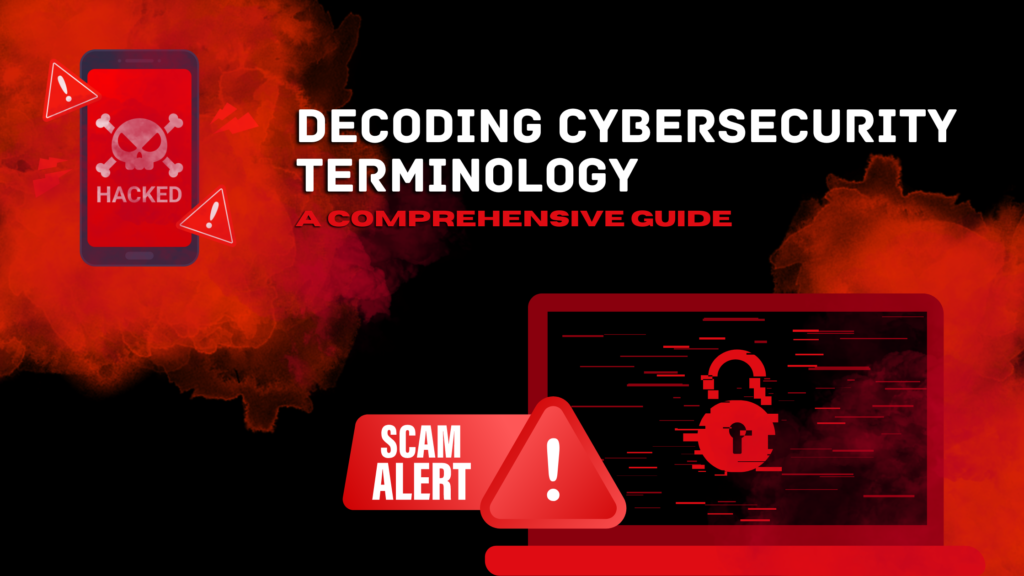In the realm of Cybersecurity, understanding various terminologies and tech jargon is crucial for individuals and businesses alike. With Cyber threats becoming increasingly more sophisticated, staying informed about a Cybersecurity terminology can help navigate the complex landscape of the digital world.
In this blog post, our mission is to unravel the complexities of common cybersecurity terms, equipping you with a comprehensive guide that will enhance your understanding and empower you to outsmart potential hackers.
Here is a breakdown of these 10 commonly used terms:
- Malware:
Malware, short for malicious software, refers to any software specifically designed to disrupt, damage, or gain unauthorized access to computer systems or networks. Common types of malwares include viruses, worms, Trojans, ransomware, and spyware. - Phishing:
Phishing is a cyber-attack technique where attackers masquerade as a trustworthy entity to deceive individuals into revealing sensitive information, such as login credentials, financial details, or personal data. Phishing attacks are typically carried out through deceptive emails, instant messages, or fake websites. - Firewall:
A firewall is a network security device that monitors and filters incoming and outgoing network traffic based on predetermined security rules. It acts as a barrier between internal networks and the external Internet, preventing unauthorised access and protecting against potential threats. - Encryption:
Encryption is the process of encoding data or information in a way that only authorised parties can access and understand it. It involves converting plaintext into ciphertext using encryption algorithms, ensuring that data remains secure even if intercepted by unauthorised individuals. - Vulnerability:
A vulnerability refers to a weakness or flaw in a system’s design, configuration, or implementation that could be exploited by cyber attackers. Vulnerabilities can exist in software, hardware, or network infrastructure, and it is essential to identify and patch them to minimise the risk of exploitation. - Two-Factor Authentication (2FA):
Two-Factor Authentication adds an extra layer of security to the authentication process by requiring users to provide two separate forms of identification. This typically involves something the user knows (e.g., a password) and something the user possesses (e.g., a unique code sent to their mobile device). - Botnet:
A botnet is a network of computers or devices that have been infected with malicious software, known as bots or zombies, and are under the control of a remote attacker. These compromised devices are typically interconnected through the internet and can be harnessed by the attacker to carry out various malicious activities without the knowledge or consent of the device owners. The attacker can remotely command the botnet to perform tasks such as launching distributed denial-of-service (DDoS) attacks, sending spam emails, spreading malware, stealing sensitive information, or participating in other illicit activities. Detecting and dismantling botnets requires advanced security measures from cybersecurity professionals. - DDoS Attack:
A Distributed Denial of Service (DDoS) attack is an attempt to disrupt the normal functioning of a network, service, or website by overwhelming it with a flood of incoming traffic. This surge in traffic, often from multiple sources, consumes the target’s resources and makes it inaccessible to legitimate users. - Intrusion Detection System (IDS) and Intrusion Prevention System (IPS):
An Intrusion Detection System (IDS) is a security tool that monitors network traffic and system events to detect and respond to potential security incidents or attacks. An Intrusion Prevention System (IPS) goes a step further by actively blocking and preventing suspicious or malicious activity from reaching its target. - Keylogger:
A type of malware that records keystrokes made by a user, capturing sensitive information such as login credentials, credit card details, or other confidential data.
Gaining familiarity with cybersecurity terminology is an important step towards bolstering your digital defences. By understanding the language used in the world of cybersecurity, you can make informed decisions, adopt best practices, and communicate effectively with cybersecurity professionals. With the ever-evolving threat landscape, staying knowledgeable about cybersecurity terminology empowers individuals and organizations to protect themselves against emerging cyber threats and ensure a safer digital environment.
www.anspired.com.au
1300 267 747.

